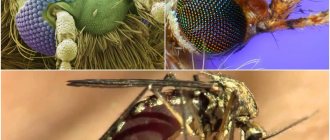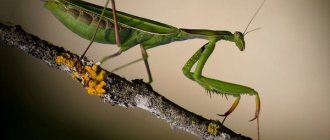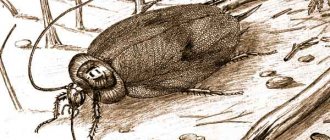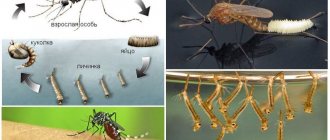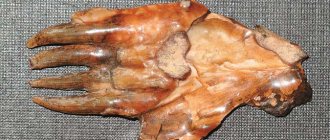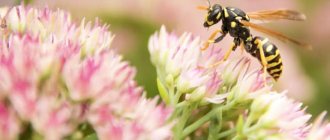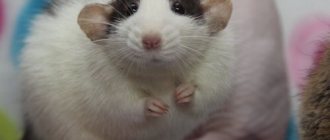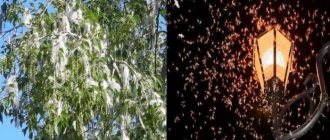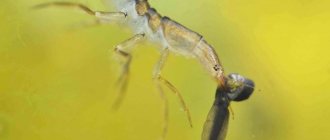Description and appearance
The wasp belongs to the suborder of the stalked bellies, the order of Hymenoptera. Scientists have still not been able to determine which class these insects belong to, so all stinging representatives of stalked bellies that do not belong to ants and bees are called wasps. There are many varieties of wasps, but there is no strict classification of this variety.
The sizes of wasps vary depending on the species, but the appearance and body structure of all members of the family are similar. A wasp is an insect with a characteristic, well-recognized, bright color. It combines two contrasting colors - black and yellow (orange). A pattern on the body in the form of spots and alternating transverse stripes.
Appearance
The size of an adult wasp can reach 12 – 14 mm in males and 18 mm in females. Representatives of certain varieties (most often living in the tropics) are much larger, they grow up to 5.5 cm.
The insect's body consists of a head, thorax and abdomen. A special feature of the body structure of the wasp is a thin membrane connecting the chest and abdomen. Thanks to it, the insect is very mobile and can practically fold in half. There are 6 legs on the chest, each of which consists of 5 segments. 2 pairs of transparent wings, the front ones being slightly longer. The abdomen of 6 segments ends with a sharp, smooth sting. The sting is connected to a gland that produces a poisonous substance.
The wasp's head is quite large. It contains antennae, eyes and mouthparts in the form of powerful jaws. In addition to two large bulging eyes, the wasp also has 3 small simple eyes. The main eyes are made up of several thousand tiny facets. Each of them captures a small part of the image, so the wasp sees the overall picture as a mosaic consisting of many pieces. Thanks to this structure and location of the eyes, the wasp’s visual angle is 280⁰.
Variety of species
The wasps that are familiar to most of us and have yellow and black stripes on their bodies are called paper wasps. This species name is due to the fact that the material from which insects build their homes is very similar to paper. It is made from wood fibers chewed by arthropods, which are glued together with saliva.
Other types of wasps have different colors. The size of the insect depends on its species. They range from 1.5 cm to 10 cm. What do wasps eat? The adult eats mainly liquid food - nectar, fruit juice. For their larvae, wasps get: flies and other insects. Predatory wasps themselves eat insects, and can also feed on other types of food.
The wasp catches its prey and injects its poison into it through its sting, which does not kill, but only paralyzes. Thus, the meat of the prey is kept fresh until the time of the meal.
Different types of wasps live almost everywhere. For example, ground wasps choose soil to build their “homes”. Paper wasps build their “family nest” under a tree branch or on any structure. It should be noted that wasps are very willing to settle near people. This proximity makes it much easier for them to find food.
The wasp eats sweets and other foods left in a visible place in a person’s home. But also, it catches pests there such as flies, which carry various infections and thereby brings benefits. In the garden, wasps can find not only flies and ants, but also a huge number of insects that are pests. Wasps love honey very much and therefore pose a threat to bees.
The queen is the largest individual of the paper wasp family. The length of its body is approximately 20 millimeters, while the body length of a working wasp or drone is about 18 millimeters. Females have a larger abdomen than males. Insects do not differ in body color by gender. Males and females have the same yellow and black striped color.
Why are wasps needed in nature?
Few people know that wasps are very beneficial. And their main role is that they, being predators, destroy various insects, regulating their numbers. Adult wasps most often feed on nectar and fruit juice, and the prey is fed to larvae, which need protein to quickly grow and replenish the swarm. Striped insects prey on:
- flies;
- caterpillars;
- spiders;
- mosquitoes;
- Zhukov.
Among these insects there are many that cause damage to agricultural plants (cutworms, chafer larvae, leaf beetles, aphids, borers). A wasp swarm can clear a garden or vegetable garden of pests in a short time, thereby helping to preserve the harvest.
In addition, wasps pollinate plants. Of course, they cannot be called first-class pollinators, but still, when flying from flower to flower, insects transfer a certain amount of pollen on their body and legs.
There are several species of wild wasps that produce honey. Due to the lack of special enzymes, the product is inferior in quality to that of bees, but it is still quite tasty and nutritious, and can be eaten.
Where do wasps spend the winter and when do they wake up?
We have already said where wasps spend the winter. But the above did not apply to old females, who are practically no longer able to bear offspring. They do not look for wooden structures, stumps and leaves to survive the winter safely. Old females scatter, as they say, “wherever they look.” And as soon as the temperature drops below zero, they become completely inactive. The result is immediate death. Such is their lot.
But the surviving wasps are waiting for fifteen-degree heat. And, having gained strength, they leave their winter homes. Now the main goal of the wasps is to build a nest. We advise you to get together with all your household members in the fall and carry out preventive cleaning of the area. Believe me, it will not be superfluous. This way you will destroy the “secret hiding places” of insects in the same accumulated foliage.
Where do they spend the winter?
When daylight hours and air temperatures decrease, the wasp family begins to look for a place to winter. The best place for wasps to hibernate is under the bark of trees, as deep as possible. You can also hide in an old stump, under leaves that have fallen from trees, and in the crevices of buildings.
Winter houses for wasps
As soon as the first cold weather sets in, summer residents calmly remove and burn wasp nests. They know very well: the insects have already flown away. In fact, the destruction of empty nests only has a certain preventive role. The fact is that wasps like to nest where there are already other wasp nests nearby. And it’s better to get rid of the old nest: suddenly the wasps won’t come again!
Before wintering, females actively mate, and then fly away in search of a suitable place for wintering. What attracts insects, and where do wasps usually hibernate? They love fallen trees. Rotting stumps also become a home for wasps. If a good litter has been formed from fallen autumn leaves, insects will definitely live in it and stay there until spring.
Females, for the most part, look for cracks in the bark and climb into them. If there are a lot of cracks in your country house, then insects can get into them and stay there until the first warm days. The main thing is that wasps do not end up on the inside of your house. Any wooden buildings, especially old barns, can become an “apartment” for insects. And you need to be prepared for this.
There should not be large temperature differences where wasps hibernate. When there is a harsh winter or, conversely, little snow, many females die. Even before they have time to recover from hibernation, wasps become desirable prey for birds, which cannot help but take advantage of the arrival of winter thaws. But, naturally, some insects remain alive. And the new generation appears quite quickly, which in any case has a positive effect on the population.
Wintering places
In the summer, wasps can be found almost everywhere in nature. Before the fruits ripen, these insects actively eat pests. Their numbers are usually small. However, as the fruits ripen, the number of insects increases.
The first young wasps are sterile females. They help the queen care for the new generation and build a nest. At the end of summer - beginning of autumn, young queens and males mate. With the arrival of cold weather, the nests quickly become empty: most of the male and working individuals die.
And young females choose places that are completely hidden from human eyes as their winter “dwelling.” In most cases, this is the thickness of wood, old stumps and cracks in outbuildings or houses.
Features of wintering
Insects begin to arrange winter shelters when the air temperature drops to + 10 degrees. During this period, already fertilized females try to occupy the deepest places.
Many people are interested in how wasps overwinter in the wild. When real cold comes, their body accumulates quite a lot of special cells that play the role of antifreeze. They lower the freezing point and prevent the body's cells from being destroyed under the influence of low temperatures. Insects tolerate snowy winters best.
Do wasps hibernate? This state is called diapause. All metabolic processes in the body slow down, external nutrition completely stops. Insects become drowsy and inactive. Insects obtain the necessary substances from their own body reserves. Wasps do not gorge themselves especially before winter. Everything that they accumulated in the body over the summer becomes a source of food for the whole winter. Awakening begins when the temperature reaches +10 – + 15 degrees.
How is it different from a bee?
Visually distinguishing a wasp and a bee is quite easy, you just have to take a closer look at the insects. Despite the fact that the color of the insects is similar, the color of the wasp is brighter and more contrasting. The bee against the background of the wasp looks more faded, and the pattern on the body is more blurred and smeared. The body of the bee is stockier, there is no “wasp waist”. In addition, there is much more hair on the body of a bee.
wasp sting
In addition to appearance, insects have other differences:
- The bee has a jagged sting, while the wasp has a smooth one, so that it can use it repeatedly without harm to itself;
- bees eat pollen, nectar and honey, the wasp's diet is much more varied;
- bees are usually smaller in size.
Bees are calmer insects, while wasps are annoying and aggressive.
Interesting facts about wasps
In the fall, they scatter around the surrounding area and after that they no longer show their former activity and become much more vulnerable, sleepy and inactive. The fate of each individual individual develops differently. Some of them simply live out their lives as summer ends. After that they freeze.
If we are talking about fertile and fairly young females, then they usually mate at the very end of August, and then simply sleep in a secluded corner. This is necessary in order to continue life after the onset of spring (with the onset of heat). At the end of the season, the males die, as well as the working females and the old queen. It also happens that fertile females are born only at the very end of the season.
Another circumstance that has a strong impact on the situation with these insects is the slowdown of metabolic processes in the body of the uterus. After this, preparations for wintering begin. The body temperature of these insects begins to drop to a minimum level, which will help cope with freezing on too cold winter days. Wasps in winter are able to withstand even the harshest conditions if they manage to find a secluded place.
Sources
- https://7ogorod.ru/prochee/skolko-zivut-osy.html
- https://eparazit.ru/gde-zimuyut-osy.html
- https://beetlestop.ru/gde-zimuyut-osyi/
- https://apest.ru/osy/ob-osah/zimuyut-osy/
- https://sesrus.ru/gde-zimuyut-osy
- https://DomPchel.ru/pchelovodstvo/poleznoe/kak-zimuyut-osy/
- https://www.dacha6.ru/gde-zimuyut-osy-givuschie-pod-kryshei/
- https://queenbee.ru/osy-shershni-i-shmeli/gde-zimuyut-osy
- https://vredstop.ru/osy/gde-zimuyut-osa.html
[collapse]
Types of wasps
All types of wasps can be classified into one of two categories:
- public;
- single.
These groups differ in their lifestyle and ability to reproduce. Solitary ones, as the name implies, do not need the company of their own kind, while social ones unite into huge families under the control of a queen or a royal wasp.
Social wasps
Social wasps live in huge colonies of thousands of individuals. They build nests, the diameter of which, unlike the size of the swarm, can vary from 10 cm to 1 m.
A wasp family is headed by a queen, whose main goal is to reproduce. The remaining members of the family are called worker wasps, and they perform a wide variety of tasks from guarding the nest to foraging for food and feeding larvae. Family members communicate with each other using special signals.
Solitary wasps
Solitary wasps live separately. They either make very small nests or do without them at all. The main task of such insects is to store as much food as possible for their offspring. The fact is that solitary wasps do not really care about the larvae. They bring prey paralyzed by poison to the nest and then fly away. Then the larvae will develop independently until they turn into young wasps.
Uterus
The queen wasp is the most important person in the family. No wonder they call her the queen. She looks for a suitable place for a nest, begins its construction, looks for food and lays eggs. After the first generation of young insects appears, the queen wasp stops getting food and doing construction; from now on she is only engaged in giving birth to more and more new members of the colony.
Externally, the wasp uterus looks like a typical representative of its genus. But it is not difficult to recognize it, because among other wasps it stands out in size. Usually the uterus is 35 - 30% larger than other family members.
What types of wasps are there?
Wasps are considered to be all stinging insects from the order Hymenoptera, suborder Stalk-bellied, except those that belong to bees and ants. All types of wasps are divided into two main groups:
- public;
- single.
As the name implies, the former unite in communities, the latter prefer to live separately. Hornets belong to the social category. Among the solitary ones are the sand wasp, German wasp, and Scolia.
An interesting fact is that among bees, which are considered one of the most social insects, there are also loners. This is, for example, a carpenter bee, which is popularly called a seven-stinged bee.
Paper or social wasps
Social wasps live in colonies that number from several tens to several thousand individuals. The family consists of a queen (sometimes there are several of them), whose function is the reproduction of offspring, and worker bees, which, depending on their belonging to a particular caste, perform certain duties.
The group of social wasps includes 2 subfamilies:
- vespina;
- polysteen.
On a note! This type of wasp received the name “paper” because their nests are made of a material similar to paper. With the help of strong jaws, the wasp chews wood fibers, moistening them with saliva, and then stretches the resulting viscous mass, forming new nest cells.
Vespina
This subfamily includes the most advanced insects, which are characterized by complex behavior and intricate nest designs. There is only one queen in the Vespina family. It is she who is involved in the founding of the colony, starting the construction of the nest, laying eggs and feeding the first generation of larvae.
After the first working individuals grow up, they take on all the work of building a home, as well as obtaining food for the growing larvae. The duties of the queen include only laying eggs.
Vespina
With the beginning of autumn, females appear that are capable of bearing offspring. They mate with males and hibernate to begin creating new families in the spring. The old queen, worker bees and male bees die in the fall.
Polistins
The polystin subfamily includes the largest number of species (more than 800). Some species have primitive behavior and simple nests in the form of an open honeycomb, in which from 10 to 100 individuals can live. Other polystines exhibit complex behavior and construct complex, multi-tiered nests that are home to thousands of wasps. Colonies can be founded by a single queen or several queens.
Flower wasps
Flower wasps are solitary. The insects are small, body length rarely exceeding 10 mm. The color is black with yellow stripes and spots. Insects feed on pollen and nectar and settle close to the food source. Flower wasps build nests on tree branches or on the ground. The building material is a mixture of sand and clay, held together by insect saliva. The female lays an egg in the nest, fills the cell with nectar and pollen, and seals it. The hatched larva feeds on the left reserves, then pupates and an adult wasp emerges from the cell.
Hornets
Representatives of this species are among the largest wasps, their size can reach 55 mm. In addition to their size, hornets are distinguished from other wasps by their rounded abdomen and color, which contains not only black and yellow, but also orange and brown. They mainly live in the Northern Hemisphere.
Adult insects prefer food with a high sugar content (nectar, honey, honeydew, juice and pulp of fruits), and to feed the larvae they catch insects (flies, grasshoppers, locusts, bees and other wasps). For people, a hornet sting is very painful, and the poison causes severe allergies.
Hornet
Shiny wasps
The glitter wasp is a fairly small wasp, the size of which varies from 3 to 15 mm depending on the species. Its difference is its bright color, unusual for a wasp; the body can be green, blue, purple with a metallic tint. These insects are parasites; bees, sawflies, other species of wasps, spiders, and butterflies are chosen as victims.
Road wasps
The road wasp is a fairly large insect; representatives of this family reach a size of 15–40 mm. Body color is black with yellow, orange or red spots. The difference between road wasps is their long hind legs. Each leg has a process with which the insect can loosen the soil. These insects live in burrows in the ground and rarely fly. Females lay eggs on spiders, which are first paralyzed with poison and dragged into their home. Road wasp venom is very toxic.
Road wasps
Germans
German wasps are also called velvet ants. This is due to the fact that females do not have wings, and their body is shaped like an ant and covered with soft hairs. In this species, the males are much larger than the females, which is not often the case with wasps. The body is black, the breast is red, and the color of females is much brighter.
German women never build nests. They take over the homes of other wasps, bees, and flies, where they lay eggs on the host larvae, which, after hatching, feed on their own larvae.
Scolia
Scolia are one of the largest wasps, their body length reaches 60 mm. The color is black with white, yellow, orange or red spots. Adults feed on nectar and pollen, while the larvae parasitize the larvae of the cockchafer, weevil, and rhinoceros beetle.
A Scolia bite is dangerous only for people with individual intolerance to the components of the poison; most often, the first reaction to the toxin is numbness at the site of the bite. But this symptom goes away quite quickly.
Typhia
Typhia are small wasps, the size of which varies from 5 to 12 mm. The most common color is a black body with thin yellow stripes. The peculiarity of this species is the ability to curl up into a ball in case of danger or during hunting. Insects lay eggs on the shells of some types of beetles. The hatched larvae gnaw through the chitinous shell and feed on the tissues of the beetle.
Typhia
Rider
Representatives of this family have an elongated body, which can reach a size of 3 mm to 3 cm. Ichneumon wasps differ from other wasps in that they do not have a sting. Instead, insects have an ovipositor. With its help, they lay eggs in caterpillars, beetle larvae, and spiders. The wasp positions itself above the victim and inserts the ovipositor into the body. The larvae appear inside the victim and develop by eating its tissues and organs.
Black ground wasp
The black ground wasp is the largest representative of road wasps. Just like Sandy Ammophila, which belongs to the genus of burrowing wasps, this species prefers to live in the ground, making comfortable burrows for itself. The name is due to the appearance of the insect - the wasp is black in color with a purple or blue tint.
Attention! The black ground wasp has a very toxic venom and a long, powerful sting. Its bite is very painful and can provoke a severe allergic reaction.
Lifestyle and habitat
The habitat of wasps is almost the entire globe. These insects are not found only in the hottest and coldest regions - at the poles and the equator. The most common species is the common wasp. Insects prefer temperate climates, mainly settling where there are forests. Wasps need trees to obtain material for building nests.
Nest
The lifestyle of insects is largely determined by their belonging to one category or another. Solitary predators spend most of their lives hunting for prey; social wasps live a much more interesting life, performing various tasks for the benefit of the family.
What kind of homes do wasps have?
Single wasps, depending on the species, can arrange a home for themselves:
- from mud;
- digging a hole underground;
- gnawing a hole in wood;
- making a shelter out of clay.
Sometimes they make nests with just a few cells.
Social wasps live in nests. This is a complex multi-level structure, which insects are constantly improving and completing. The nest looks like a smooth gray-brown egg.
The building material is wood, which insects soften with saliva and then chew. Gradually the material becomes sticky and stretches well. The wasp stretches the building material and uses its jaws to form honeycombs. So, constantly adding new cells, the wasps form their home.
Inside the hive there is a special room for the queen, compartments for larvae, and storage rooms for supplies. The inside of the nest is the safest. For its construction, insects use wood chips. In general, the material of the nest is very similar to paper. That is why another name for social wasps is paper.
Nutrition
The diet of wasps is quite varied and is largely determined by the insect’s habitat, and also depends on what stage of development it is at. Adults of many species prefer nectar, honeydew, juice and pulp of fruits.
Predatory wasps feed on the same things they feed the larvae, namely, insects and spiders. Most wasps will not refuse food from a person’s table. They are attracted to:
- meat;
- fish;
- jam;
- compotes;
- kvass;
- beer.
In general, insects are quite unpretentious and are content with what they can get.
Can a wasp see at night?
This insect is diurnal. It is during the day that she can find food for herself or material for building a nest.
Some species are also active at night. Quite often you can see a flying hornet at night - this is a type of wasp.
Appearance of hornets
But still, most of these insects prefer to wait out the dark time of day in a secluded place.
It is difficult to say whether wasps can see in the dark. But the low activity of insects at night may be one of the signs that their vision in the dark is much worse than during the day.
Wasp trap with ready-made bait “Wasp Trap”
Most often, wasps that do not make it to their nest hide in flower baskets. Tenacious legs and strong jaws allow them to survive the dark. The life of a wasp is quite short. Scientists have proven that she does not waste time sleeping.
The process of building a wasp's nest
If the wasps do not fly at night, then they are quite active in their own home and continue to carry out everyday activities: caring for the larvae and building additional cells.
The presence of a light source at night slightly changes the insect's behavior. Next to him she is more active, crawls and even flies, but without leaving the circle of light.
This behavior allows us to answer the question: do wasps see at night, rather negatively. More or less active behavior is observed only where there is additional lighting.
You can also read our article: Forest wasp: photos and taxonomy of insects
Reproduction and lifespan
The life cycle of a wasp can last from several months to several years, depending on the species and habitat. The queen lays eggs, from which larvae emerge, which then pupate and a young wasp emerges from the pupa. Wasp larvae are completely different from adults; they look like worms with a segmented light yellow body and a dark head.
Pairing
The lifespan of worker sterile wasps is about 2 months, males live much shorter and die soon after mating, the queen can live from 9 months to 2 years.
Social wasps
Reproduction of social wasps begins with the queen laying eggs in constructed honeycombs and independently caring for the offspring, providing them with food. As soon as the first generation grows up, all the worries about building and maintaining the nest, as well as obtaining food and feeding the larvae, are taken over by worker wasps. As long as the worker wasp lives, she performs certain duties for the benefit of the family.
The development of larvae in a large family occurs quickly, since the working individuals bring a sufficient amount of protein food.
On a note! An interesting feature of wasps is that the larvae are fed differently, depending on what functions they will have to perform as adults. Future infertile worker bees receive sugary substances; those who will be able to reproduce receive chewed insects.
Solitary wasps
Solitary wasps do not reproduce as rapidly as social wasps. After mating with the male, the female lays eggs in a hole or cell, where she brings prey that the hatched larva will feed on. Sometimes the wasp lays eggs directly on the body of a paralyzed victim. After this, the female seals the hole, and then makes a new one, where she brings a new victim and lays eggs again.
Wasp control work in the autumn-winter period
In the autumn and winter, owners of vineyards and orchards should not relax, waiting for the summer “attack” of wasps on fruit and berry crops. A number of works should be carried out in winter, so as not to waste precious summer hours, which are always in short supply.
- In late autumn, you should check places where wasps may have lived - attics, sheds, corners in sheds and others. Found empty nests should be removed and burned, and the places where they are attached should be treated with some kind of odor-reducing agent. Kerosene, machine oil, dichlorvos, etc. are suitable. This will not harm the insects, since the wasps have already left their nest, but in the spring, the awakened females will look for places to build a new hive. They like to settle near old nests. The absence of old hives and the intimidating smell will force females to look for other places to create a new family.
- With the onset of cold weather (below + 10 degrees), possible wintering sites for females should be collected and burned on the site - old rotten stumps, cut trees. The loose bark should be torn off from dried trunks. Piles of dry leaves should be burned and compost heaps should be poured with boiling water. It is advisable to stir up and turn over or move the boards, pieces of roofing felt and slate to another place. If the wasps have settled down for the winter under them, then, left without shelter, they will die.
- During the winter, you can collect empty plastic bottles and make traps from them. 0.7-liter jars with plastic lids are suitable for the same purposes.
- On free evenings, you can prepare bags for tying bunches of grapes. Gauze, unnecessary tulle or old thin tights are quite suitable for this.
- Preparations should be prepared to combat these insects. It is advisable to stock up on insecticides for baits and traps (boric acid, which is sold in pharmacies, can be successfully used), as well as sprays to destroy nests.
“Armed” in advance, it will be possible to begin the fight against wasps in a timely manner and prevent significant crop losses.
Fighting wasps in the autumn-winter period
Prepare your sleigh in the summer, and start fighting wasps in the winter. Just because wasps have left their nests for the winter doesn't mean they won't return in the spring. Therefore, certain work must be carried out while there is no one in the nests, or rather, as soon as the temperature outside the window drops to 9 - 10 degrees. This makes the task much easier.
First of all, it is necessary to carefully examine their possible wintering places - attics, sheds, all dark and dry corners. Look into every crevice where wasps could possibly live. If boards and other things are piled up on the site “just in case,” they should be moved to another place or rearranged. If wasps were hiding there, then if they were left without a roof over their heads, they would quickly die.
If you find a nest or something similar to it, remove it carefully and destroy it. The place where you found the remains of a wasp nest must be watered with something with a strong and pungent odor. Kerosene, for example, or dichlorvos. These measures will lead to the fact that next year the wasps will look for other nesting places. In addition, before snow falls, it is necessary to collect and burn fallen leaves, if possible, remove dry branches and trees from the area, or peel off the bark from them. Thus, we will significantly reduce the number of places where wasps can hide for the winter. The right owner will not forget to replenish supplies of insecticides. In winter, they are needed much less and, accordingly, their price is lower. Whether to collect plastic bottles for traps or not is something everyone will decide for themselves. Considering that almost all liquids are sold in such bottles, it is not advisable to collect and store them all winter.
Natural enemies of wasps
Even wasps, which have a frightening coloration and a poisonous sting, have enemies in nature. These include:
- ants - destroy wasp nests, destroy sick and weakened individuals;
- fantail beetles - these beetles parasitize wasp larvae;
- praying mantises;
- hornets - oddly enough, these insects sometimes prey on smaller wasps, despite the fact that they are their closest relatives;
- birds (more than 100 species, including bee-eaters, honey beetles);
- animals - skunks, weasels, mice, rats, badgers, bears.
The frog and the toad are not averse to eating a wasp.
Wintering process
Wasps live in winter in places hidden from human eyes. In most cases, in wood. They can hide and sleep under the bark, in old stumps, abandoned hollows, and crevices. Snowy winters contribute to successful wintering. The thaw has an unfavorable effect when the ice cover melts, the cracks become open to wind and frost. Unfavorable weather conditions, as well as natural enemies, prevent insects from overwintering.
In the wild, insects become victims of birds and animals. Bears deliberately tear open old hollows and eat prey before the insects can get out in the spring. Whether or not wasps sleep in winter is a controversial issue. This is a unique condition, as a result of which activity is lost, metabolic processes slow down, and nutrition as such stops. Wasps become inactive during the winter and save energy. With the onset of warmth, they awaken and continue normal life activities.
Reproduction of wasps
In the life of a wasp, the differences between solitary and colonial bees are quite large. For example, single wasps (in particular, male wasps, since the queen does not leave the hive) only prepare a victim for their offspring, and that’s where the care ends. But colonial species of insects make nests, laying their eggs in them. The larvae that hatch from them, and later, young individuals, begin to care for the nest and find prey, and the queen is only engaged in expanding the family.
Wasps make their home from the young bark of trees, gluing them together with their secretion secreted by the submandibular glands. This further represents a material similar to newsprint.
Interestingly, wasps never fall asleep, although they significantly reduce their activity with the onset of darkness. At night, they usually chew bark, turning it into building materials.
All individuals inhabiting the nest are female. At the end of summer, the black queen begins to lay eggs, where both female and male individuals will be found. Subsequently, the process of swarming occurs, they mate and leave their native nest forever.
Females that have been fertilized find a place to overwinter and begin building their nest in the spring. But the males, as in the case of bees, die after fulfilling their direct function. The cold season becomes the end for worker wasps and the female who was the founder.
How a wasp breathes
In addition to food and water, air is needed to maintain life. The respiratory organs of wasps are a whole system of tubes and sacs. Scientists call them tracheas. Breathing is carried out through special spiracles located on the sides of the body. They are presented in the form of tubes, ending in special bags inside the body.
Numerous tubes extend from the air sacs, which support the functions of the internal organs. The insect can control the supply of oxygen during respiration using a closure valve. Thanks to it, dust and dirt do not get inside.
During the process of breathing, the wasp contracts the muscles of the abdomen and chest. Air enters the trachea and is pushed out. The number of breaths depends on the ambient temperature. The need for fresh oxygen is very great. The respiratory sacs are well developed in the queen, but most of all in drones.
